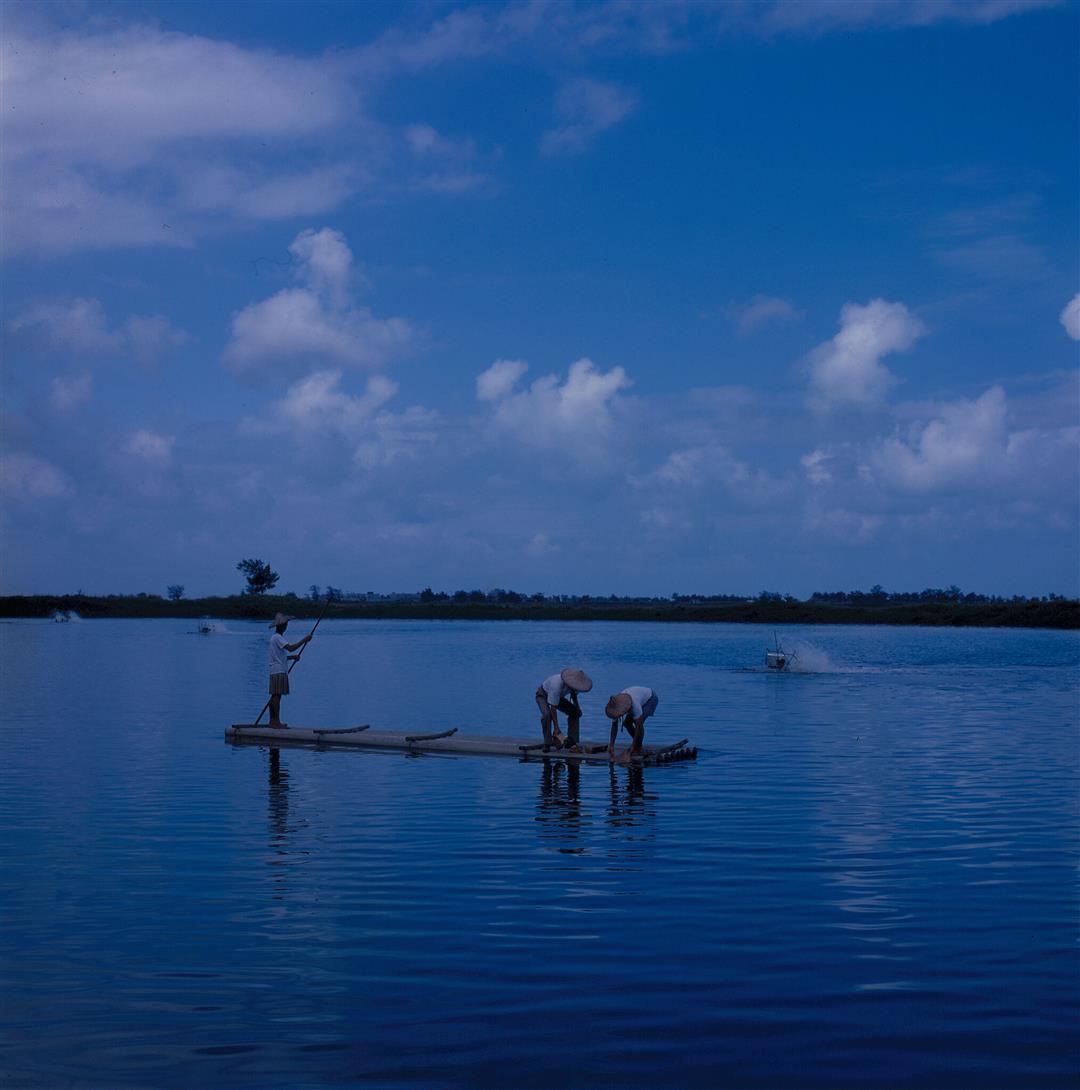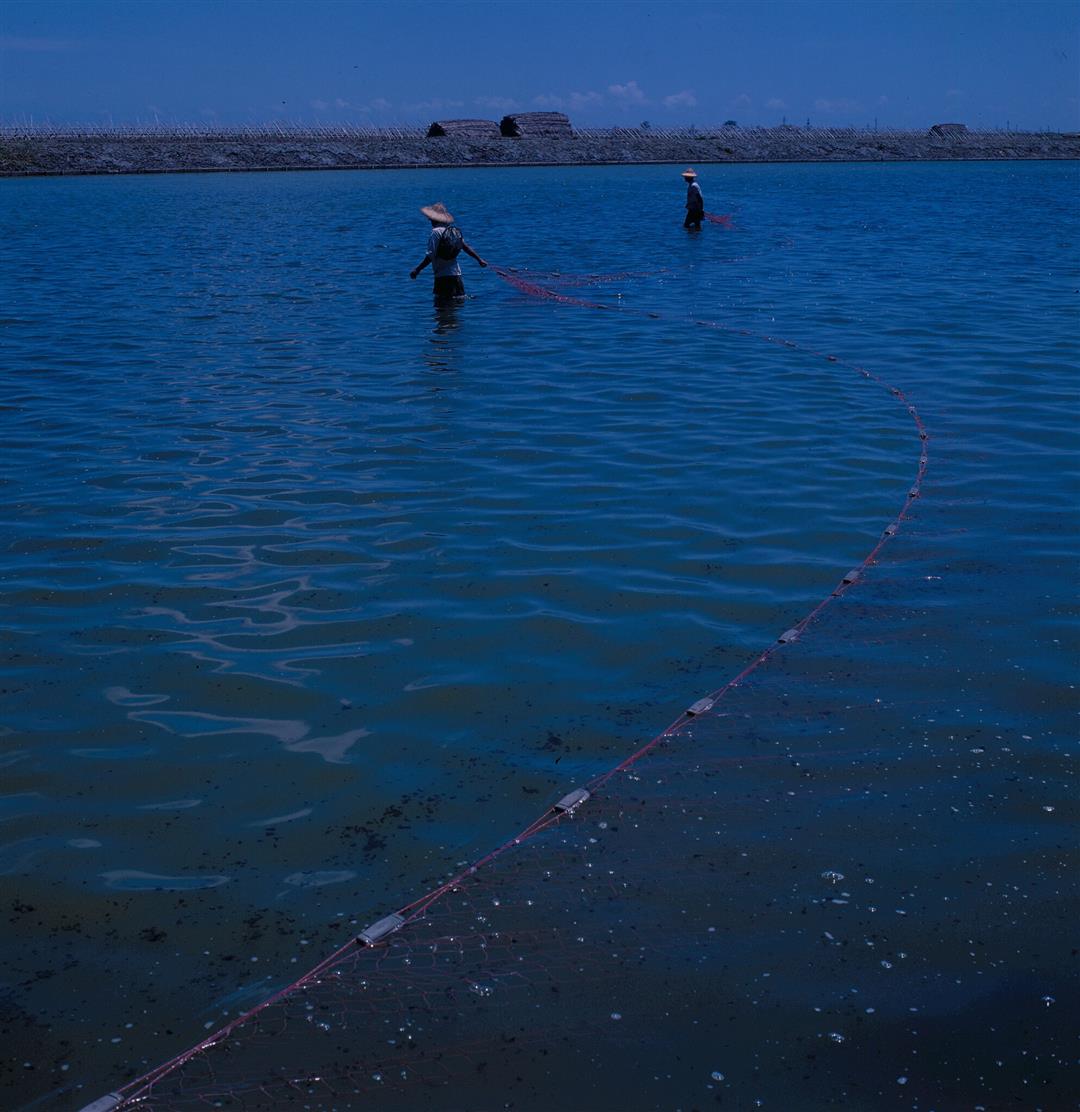A succession of milkfish ponds can be found dotted on tidal lands in Yunlin, Chiayi, Tainan and Pingtung counties along the southwest coast of Taiwan. Milkfish, also called Bandeng or Bangos, is a silvery marine food fish collected when young and raised for food in brackish or freshwater tropical ponds. It is a toothless herbivore, 0.6 to 1.5 meters long, with a deeply forked tail. It is found throughout the warmer regions of the Pacific and Indian oceans, but the heaviest concentration is in Southeast Asia. The Republic of China, with milkfish ponds covering a land area of 16,000 hectares, is one of the three leading countries in the world in milkfish culture. The other two are the Philippines and Indonesia.
Milkfish flesh is rich in protein and is of high economic value. It is delicious cooked in soup, congee, broth or noodles, and is used as bait to catch tuna or marlin.
The history of milkfish culture in Taiwan can be traced back to the time of Koxinga at the end of the Ming Dynasty about 300 years ago. Although the period from November to March is too cold to raise milkfish, it is most suitable to do the preparation work for the next season. The fish farmers can be seen cleaning ponds, tending aquatic plants and collecting milkfish fry. The most important job is to cultivate algae in the ponds, because this comprises the main food for milkfish. Other favorite foods include rice husks, peanut cakes and bean cakes.
After the Tomb-sweeping Day in April, the farmers are ready to raise fish fry in the ponds. At present, Taiwan consumes about 160 million milkfish a year, but the total harvest is only some 100 million. The deficiency is made up by imports from the Philippines, Malaysia and Indonesia. To save on foreign exchange, local fishery specialists have been trying to spawn milkfish to reach the goal of self-sufficiency. After eight years of experimentation and research, Tseng Lei-chiang from Pingtung County successfully spawned 157 milkfish hatchlings in July this year by hormone treatment. Although this amount is small, it does represent a first for the Republic of China--and the world.
A distinguishing feature of the milkfish culture ponds is the small huts lining the banks, where the night caretakers live. Inspection and constant care are especially important, because the algae and other aquatic plants release oxygen by day and carbon dioxide at night. This means the milkfish have to come to the surface to breathe at night. If water is not changed regularly, or fish are not removed from the pond if a shortage of oxygen occurs, they may die in huge numbers, and a catastrophic loss results. The Tainan Fishery Center, however, has found a way to solve this problem. By setting up an electrically powered water wheel to augment the dissolved oxygen, the farmers are able to cultivate 5,000 milkfish per hectare, twice previous levels, and earn many more millions of dollars a year.
In addition to threats stemming from shortage of oxygen, and accidents, the milkfish have several natural enemies, such as mouth breeders, haematococcus and argulos foliaceus. The former two tend to consume or destroy the aquatic plants, and the last attach themselves to the body of milkfish and damage their scales. Effective treatments have been adopted to counter these threats. But so far, no measures prove effective in destroying the bacteria that causes red spot disease. The Tainan Fishery Center is currently cooperating with the Tavolek Co. of the United States to work out counter measures.
The onset of cold weather in the winter season is often fatal to milkfish. Traditionally, tarpaulin shelters are installed over fishponds to protect them from strong winds. PE bubble plastic shelter is also used to cover the water, or warmer water pumped in to raise the temperature.
Many people are inclined to believe that fishermen lead a poor, conservative and backward life. In fact, the scientific management of the fishery industry in Taiwan teamed up with the fishermen's research and the government's policy of taking care of them, has enabled the fishermen to lead a better life. Many milkfish farmers use the money they earn to build factories or restaurants to help boost local industrial and business development. When the spawning technique is adequately refined, Taiwan should have no difficulty in obtaining adequate quantities of milkfish fry in the future, and the fish supply will be enough to meet all local demand. This will represent a breakthrough in milkfish culture in Taiwan.
[Picture Caption]
From a bamboo raft, the farmers deliver food including rice husks, peanut cakes and bean cakes to the milkfish (above). The fishermen use a gill net with a large mesh to frighten the fish, so they will regurgitate their food, and thus preserve their freshness.
Tarpaulin shelters are installed over fishponds to protect the milkfish from strong winds (above), and right, researchers in the Fishery Center study up-to-date techniques which enable fish farmers to improve their livelihood.

From a bamboo raft, the farmers deliver food including rice husks, peanut cakes and bean cakes to the milkfish (above). The fishermen use a gill net with a large mesh to frighten the fish, so they will regurgitate their food, and thus preserve their freshness.

From a bamboo raft, the farmers deliver food including rice husks, peanut cakes and bean cakes to the milkfish (above). The fishermen use a gill net with a large mesh to frighten the fish, so they will regurgitate their food, and thus preserve their freshness.

Tarpaulin shelters are installed over fishponds to protect the milkfish from strong winds (above),.

and right, researchers in the Fishery Center study up-to-date techniques which enable fish farmers to improve their livelihood.

and right, researchers in the Fishery Center study up-to-date techniques which enable fish farmers to improve their livelihood.